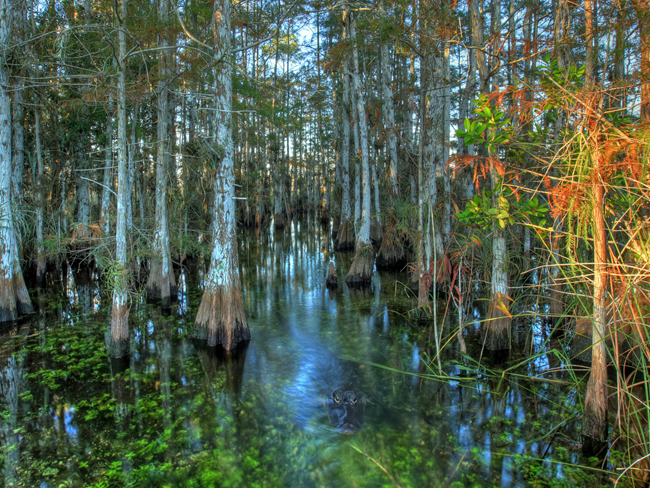
NPS photo
Peatlands
"Bogs" and "fens" are the major types of peatlands. They occur in old lake basins or other topographic depressions in the Great Lakes region, western mountain ranges, much of Alaska, the Atlantic and Gulf Coastal Plains, and many other locations. Sphagnum moss, orchids, and insect-eating plants like sundews, pitcher plants, and Venus' flytraps are specially adapted to the nutrient-poor, acidic conditions found in bogs. Fens are richer in nutrients and less acidic than bogs, and are typically covered by sedges, grasses, rushes, and wetland wildflowers.

NPS Photo
Southern Deepwater Swamps
Southern deepwater swamps are wooded wetlands of the southeastern United States that have standing water for most, if not all, of the growing season. The branches of the large bald cypress, water tupelo, and water oak trees in these swamps are often cloaked with hanging strands of Spanish moss, creating a cathedral-like atmosphere.
The Okefenokee Swamp in southern Georgia and the Big Cypress National Preserve in south Florida are two of the most well-known southern deepwater swamps in the United States.

Photo by Jannis Jocius
Inland Freshwater Marshes and Wet Meadows
Inland freshwater marshes and wet meadows include a variety of wetlands covered with soft-stemmed plants like sedges, grasses, bulrushes, and wetland wildflowers. They can occur in- isolated depressions such as the prairie potholes of the upper Midwest,
- as fringes around lakes and ponds,
- in mountain valleys fed by surface or groundwater,
- between sand dunes like those found at Indiana Dunes National Lakeshore, or
- as nearly flat expanses of emergent wetlands such as those found in Everglades National Park.

Riparian Wetlands
Riparian wetlands form on the floodplains of rivers and streams throughout the United States.In the southeast, "bottomland hardwood forests" are highly productive and botanically diverse riparian wetlands that cover vast areas along the larger rivers. Congaree National Park in South Carolina protects the largest expanse of old growth bottomland hardwood forest remaining in the southeastern United States.
In the arid west, riparian forests and wetlands occur as narrower but very productive corridors along rivers and streams that are important to aquatic life as well as upland wildlife that use them for food and cover.
Last updated: May 16, 2025
